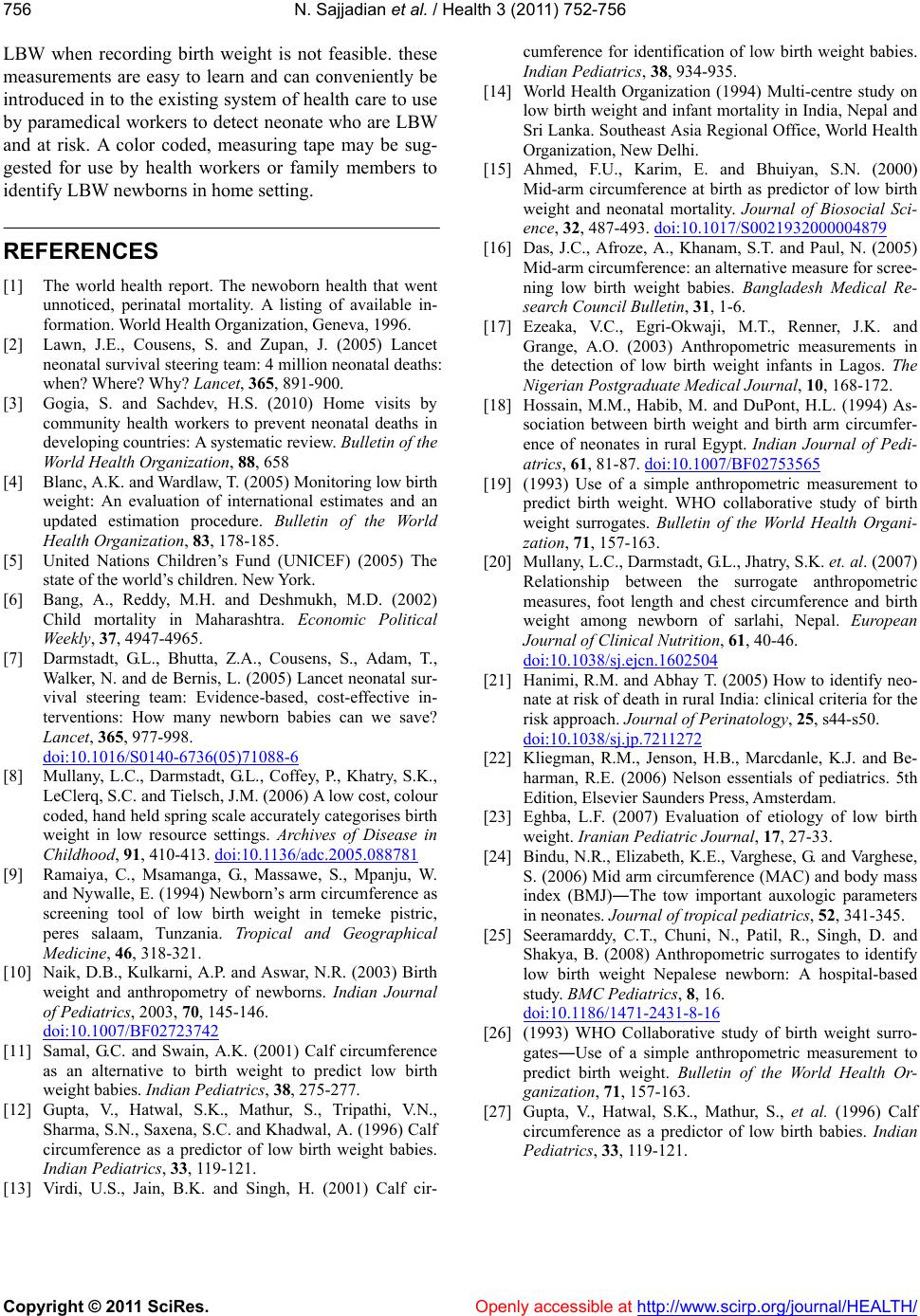
N. Sajjadian et al. / Health 3 (2011) 752-756
Copyright © 2011 SciRes. Openly accessible at http:// www.scirp.org/journal/HEALTH/
756
LBW when recording birth weight is not feasible. these
measurements are easy to learn and can conveniently be
introduced in to the existing system of health care to use
by paramedical workers to detect neonate who are LBW
and at risk. A color coded, measuring tape may be sug-
gested for use by health workers or family members to
identify LBW newborns in home setting.
REFERENCES
[1] The world health report. The newoborn health that went
unnoticed, perinatal mortality. A listing of available in-
formation. World Health Organization, Geneva, 1996.
[2] Lawn, J.E., Cousens, S. and Zupan, J. (2005) Lancet
neonatal survival steering team: 4 million neonatal deaths:
when? Where? Why? Lancet, 365, 891-900.
[3] Gogia, S. and Sachdev, H.S. (2010) Home visits by
community health workers to prevent neonatal deaths in
developing countries: A systematic review. Bulletin of the
World Health Organization, 88, 658
[4] Blanc, A.K. and Wardlaw, T. (2005) Monitoring low birth
weight: An evaluation of international estimates and an
updated estimation procedure. Bulletin of the World
Health Organization, 83, 178-185.
[5] United Nations Children’s Fund (UNICEF) (2005) The
state of the world’s children. New York.
[6] Bang, A., Reddy, M.H. and Deshmukh, M.D. (2002)
Child mortality in Maharashtra. Economic Political
Weekly, 37, 4947-4965.
[7] Darmstadt, G.L., Bhutta, Z.A., Cousens, S., Adam, T.,
Walker, N. and de Bernis, L. (2005) Lancet neonatal sur-
vival steering team: Evidence-based, cost-effective in-
terventions: How many newborn babies can we save?
Lancet, 365, 977-998.
doi:10.1016/S0140-6736(05)71088-6
[8] Mullany, L.C., Darmstadt, G.L., Coffey, P., Khatry, S.K.,
LeClerq, S.C. and Tielsch, J.M. (2006) A low cost, colour
coded, hand held spring scale accurately categorises birth
weight in low resource settings. Archives of Disease in
Childhood, 91, 410-413. doi:10.1136/adc.2005.088781
[9] Ramaiya, C., Msamanga, G., Massawe, S., Mpanju, W.
and Nywalle, E. (1994) Newborn’s arm circumference as
screening tool of low birth weight in temeke pistric,
peres salaam, Tunzania. Tropical and Geographical
Medicine, 46, 318-321.
[10] Naik, D.B., Kulkarni, A.P. and Aswar, N.R. (2003) Birth
weight and anthropometry of newborns. Indian Journal
of Pediatrics, 2003, 70, 145-146.
doi:10.1007/BF02723742
[11] Samal, G.C. and Swain, A.K. (2001) Calf circumference
as an alternative to birth weight to predict low birth
weight babies. Indian Pediatrics, 38, 275-277.
[12] Gupta, V., Hatwal, S.K., Mathur, S., Tripathi, V.N.,
Sharma, S.N., Saxena, S.C. and Khadwal, A. (1996) Calf
circumference as a predictor of low birth weight babies.
Indian Pediatrics, 33, 119-121.
[13] Virdi, U.S., Jain, B.K. and Singh, H. (2001) Calf cir-
cumference for identification of low birth weight babies.
Indian Pediatrics, 38, 934-935.
[14] World Health Organization (1994) Multi-centre study on
low birth weight and infant mortality in India, Nepal and
Sri Lanka. Southeast Asia Regional Office, World Health
Organization, New Delhi.
[15] Ahmed, F.U., Karim, E. and Bhuiyan, S.N. (2000)
Mid-arm circumference at birth as predictor of low birth
weight and neonatal mortality. Journal of Biosocial Sci-
ence, 32, 487-493. doi:10.1017/S0021932000004879
[16] Das, J.C., Afroze, A., Khanam, S.T. and Paul, N. (2005)
Mid-arm circumference: an alternative measure for scree-
ning low birth weight babies. Bangladesh Medical Re-
search Council Bulletin, 31, 1-6.
[17] Ezeaka, V.C., Egri-Okwaji, M.T., Renner, J.K. and
Grange, A.O. (2003) Anthropometric measurements in
the detection of low birth weight infants in Lagos. The
Nigerian Postgraduate Medical Journal, 10, 168-172.
[18] Hossain, M.M., Habib, M. and DuPont, H.L. (1994) As-
sociation between birth weight and birth arm circumfer-
ence of neonates in rural Egypt. Indian Journal of Pedi-
atrics, 61, 81-87. doi:10.1007/BF02753565
[19] (1993) Use of a simple anthropometric measurement to
predict birth weight. WHO collaborative study of birth
weight surrogates. Bulletin of the World Health Organi-
zation, 71, 157-163.
[20] Mullany, L.C., Darmstadt, G.L., Jhatry, S.K. et. al. (2007)
Relationship between the surrogate anthropometric
measures, foot length and chest circumference and birth
weight among newborn of sarlahi, Nepal. European
Journal of Clinical Nutrition, 61, 40-46.
doi:10.1038/sj.ejcn.1602504
[21] Hanimi, R.M. and Abhay T. (2005) How to identify neo-
nate at risk of death in rural India: clinical criteria for the
risk approach. Journal of Perinatology, 25, s44-s50.
doi:10.1038/sj.jp.7211272
[22] Kliegman, R.M., Jenson, H.B., Marcdanle, K.J. and Be-
harman, R.E. (2006) Nelson essentials of pediatrics. 5th
Edition, Elsevier Saunders Press, Amsterdam.
[23] Eghba, L.F. (2007) Evaluation of etiology of low birth
weight. Iranian Pediatric Journal, 17, 27-33.
[24] Bindu, N.R., Elizabeth, K.E., Varghese, G. and Varghese,
S. (2006) Mid arm circumference (MAC) and body mass
index (BMJ)―The tow important auxologic parameters
in neonates. Journal of tropical pediatrics, 52, 341-345.
[25] Seeramarddy, C.T., Chuni, N., Patil, R., Singh, D. and
Shakya, B. (2008) Anthropometric surrogates to identify
low birth weight Nepalese newborn: A hospital-based
study. BMC Pediatrics, 8, 16.
doi:10.1186/1471-2431-8-16
[26] (1993) WHO Collaborative study of birth weight surro-
gates―Use of a simple anthropometric measurement to
predict birth weight. Bulletin of the World Health Or-
ganization, 71, 157-163.
[27] Gupta, V., Hatwal, S.K., Mathur, S., et al. (1996) Calf
circumference as a predictor of low birth babies. Indian
Pediatrics, 33, 119-121.